Psalm 19:1-4 The heavens declare the glory of God, and the sky above proclaims his handiwork. Day to day pours out speech, and night to night reveals knowledge. There is no speech, nor are there words, whose voice is not heard. Their voice goes out through all the earth, and their words to the end of the world.
Psalm 103:11 For as high as the heavens are above the earth, so great is his steadfast love toward those who fear him;
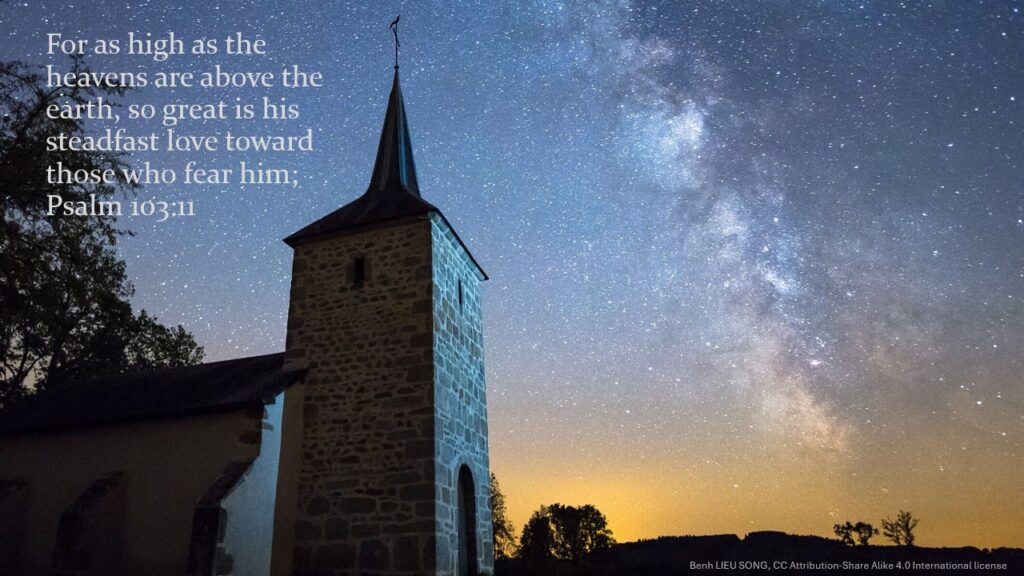
Discussion
Why are we here?
There is a reason why we live on a planet that has a transparent atmosphere that is often clear of clouds, and provides a panoramic view of the heavens. Because this allows us to have a ringside seat to the glory of God that is on display in the heavens. Creation and our existence in the creation is not an accident and not a matter of luck. Rather we, and all of creation, are here because of the free decision, power and intelligence of Almighty God.

While the beautiful poetry of the above psalms, affirm the love and majesty of God, they do not explain how we are able to see into the vast depths of the universe. This is perhaps the greatest stumbling block to those who are even willing to consider the historical narrative of Biblical creation. There have been several creation-based cosmologies proposed over the years including Dr. Russ Humphreys’ model as explained in his book, Starlight and Time, published in 1994 (1). Dr. Humphreys devised the first model utilizing Einsteinian relativity employing gravitational time dilation to explain how processes requiring millions of years or longer could transpire across the vastness of space while earth experienced just six, 24-hour days of time.
There are several interesting aspects to his model. Without getting into the nuts and bolts of his theory that involve event/time horizons, critical mass and white holes, Dr. Humphreys’ model uses all the same physics as does the secular Big Bang model, but makes a critical distinction regarding the distribution of mass in space. Specifically, in the Big Bang model all of matter fills all of space, and, as time progresses, matter and space expand together. However, in Dr. Humphreys creation based model, all of matter does NOT fill all of space. While this may seem trivial at first, the result is that natural processes will run at different rates based on their location in space due to gravitation time dilation.
The other distinction is that initially all of the matter of the entire universe was in the form of water at the center of space. There are good scriptural and scientific reasons to believe this is the case. 2 Peter 3:5 says that: “the earth was formed out of water…by the word of God.” In the Hebrew, Genesis 1:2 speaks of the Spirit hovering over the “deep,” which implies a bottomless depth of water containing all the matter of the universe, i.e. a ball of water approximately one light year in diameter. This is critical for two reasons. One is that the magnetic field of the earth and other celestial orbs (see below and the sections on the Age of the Earth and Geology for more discussion) are then directly derived from the magnetic characteristics of water that is the same mass as the object and, second, the “expanse” spoken of in Genesis 1:7 is actually interstellar space.

While groundbreaking and enlightening, Dr. Humphreys’ model and others along a similar line of analysis, have yet to resolve all the questions and issues. For example, there is observable evidence of vast processes at work, deep in space such as “colliding” galaxies, the origin and expansion of vast dust clouds, and, perhaps especially, the fact that we can even observe the incredible vastness of space given the finite speed of light. Dr. Humphreys’ model addresses many of these issues, but not all of them. Actually no model of the universe, whether creation bible based or secular materialism based, addresses all of the issues. Specifically, modern secular science has hardly been able to resolve fundamental issues regarding the current state of the universe and our solar system. These issues are seldom presented in the popular press and scientific journals, because there are no satisfying “long-age” answers.
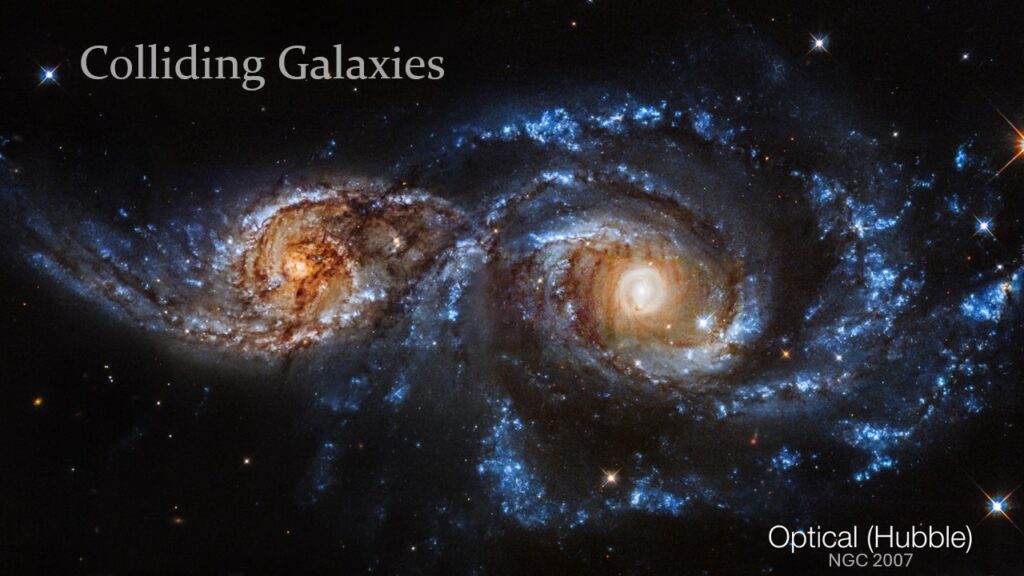

How do we explain the universe?
Beginning with the universe in its current state, there is no good “secular” explanation for its origin. To say it originated in a quantum fluctuation referred to as an infinitely dense “point” or “singularity” is not actually an answer. That does not explain how something can come from nothing. The favored response, then, is to suggest that our universe is simply one of an infinite progression of universes, the “multi-verse,” that have been spawned out of the ever-existing quantum fabric. There are at least three, insurmountable issues with the multi-verse. One, it can never be observed or tested, and therefore does not pass the test of being “scientific.” It is literally a meta-physical, that is a religious, belief without justification. Two, our universe has been observed to be so finely tuned, thus enabling the existence of the universe and mankind, that physicist Paul Davies said: …the entire universe is balanced on a knife-edge, and would be total chaos if any of the natural ‘constants’ were off even slightly (2). The conclusion is that the existence of our universe is so unlikely that the only solution for the materialists is to invent the multi-verse. Unfortunately, the multi-verse hypothesis requires more fine tuning than it was proposed to replace and is even less likely to exist then our own universe (3). Third, Medieval thinkers, both Christian and Arabic, realized that if time and matter were actually infinite, which must be the case in a multi-verse, then there is no possibility of ever arriving at the present time (or universe) (4). This may seem confusing, but it goes to the heart of what infinite time really implies. If time is truly infinite then you literally cannot arrive at the present from an infinitely distant time (…think about it…).

Admittedly, there are issues with understanding how light traverses our universe in a recent creation model, but, surprisingly, there are equally difficult issues regarding light traversing the universe in a very old universe. The issue has to do with the temperature of the universe. The universe has an extremely uniform temperature at great distance—beyond the farthest known galaxies. We know this because we see electromagnetic radiation coming from all directions in space in the form of microwaves. This is called the “cosmic microwave background” (CMB). The frequencies of radiation have a characteristic temperature of 2.7 K and are extremely uniform in all directions. The temperature deviates by only one part in 105.
The temperature difference would be like having a color difference in a bushel of wheat due to 10 red kernels of wheat in a bushel of yellow wheat (there are about one million kernels of wheat in a bushel). The problem? The only way to get such extreme uniform temperatures is to exchange energy, that is, having light traverse the entire universe. Not just light in the visible spectrum, but electro-magnetic energy across the spectrum that includes visible light. However, using the big bang supporters’ own assumptions (such as uniformitarianism and naturalism), there has not been enough time in 14 billion years (the supposed age of the universe) to get light from one side of the universe to the other; they are too far apart. This is a light travel-time problem—and a very serious one. Of course, there have been several attempts to resolve this issue, but none are generally accepted as explanations for this phenomenon. (5)

How do we explain the solar system?
Apart from the difficulties of a “secular” universe “creating” itself, there are many issues and mysteries closer to home within our own solar system. Take for example the Saturnian system with its beautiful rings and two moons. What do you think the absolute upper limit is for the existence of that system? Remember the solar system is thought to be 4.5 billion years old. Would you guess 3 billion years? How about 1 billion years, a little less than a quarter the lifetime of the solar system? That seems reasonable. However, just a few years ago the latest scientific analysis confirms that Saturn’s rings and its moons Titan and Enceladus cannot be older than 100 million years, and could be as young as 10 million years (that is, in the secular long-age estimation; they could, of course, be a lot younger) (6). In the secular time frame, if the solar system were just a week old, that would make Saturn’s rings less than 4 hours old, and perhaps as little as 22 minutes.
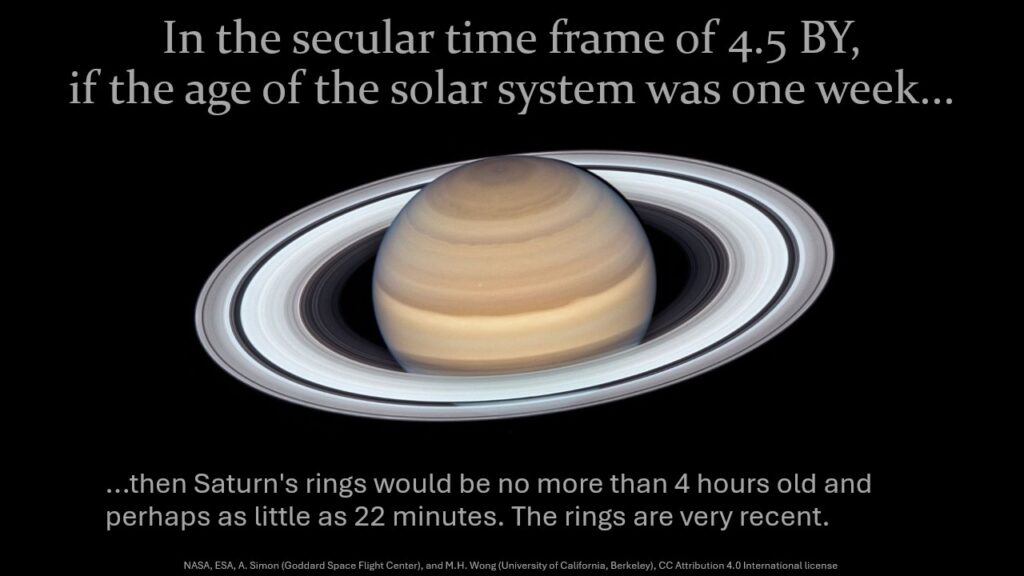
One fascinating issue is the rate at which the moon is receding. If the earth/moon system is actually 4 billion years old by secular estimates, then the moon would have been in physical contact with the earth just 1.5 billion years ago (7).
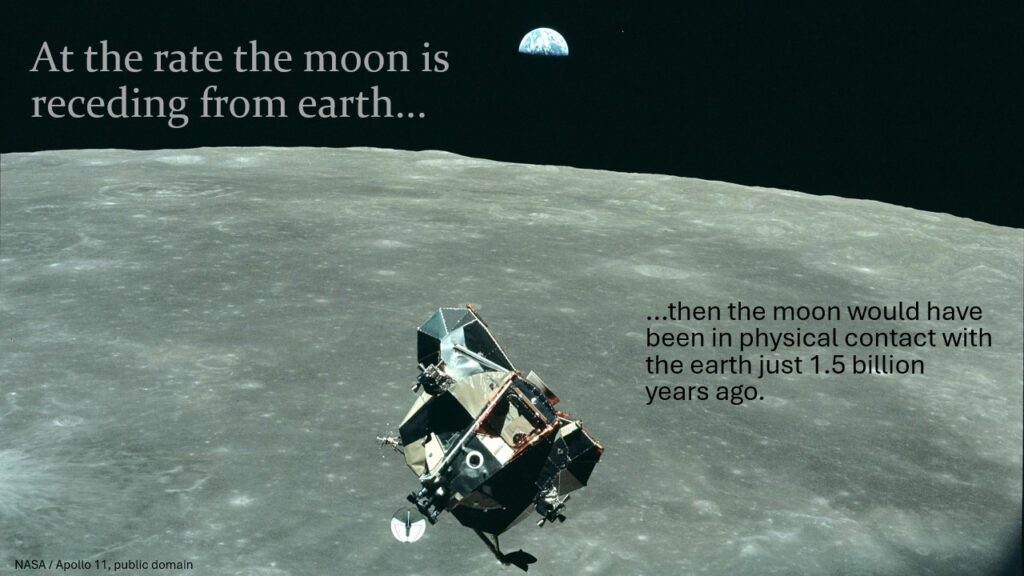
Interestingly enough the magnetic fields of various planets, including the earth, in the solar system points to a surprisingly young age for those bodies. Specifically, Mercury has a measurable magnetic field. In 4.5 billion years, since the supposed origin of the solar system, such a small body, if the core is primarily iron, should have long-since cooled to the point of being completely solid, which would “kill” any magnetic field being generated by the supposed long-age “dynamo” model of secular science. In fact, Mercury’s field has been measured to be decreasing, as is earth’s field. Are the fields decreasing because they are both undergoing reversals? How likely are two planets to be experiencing “reversal” at the same time when field reversals supposedly occur so rarely? The answer is: not very likely at all.
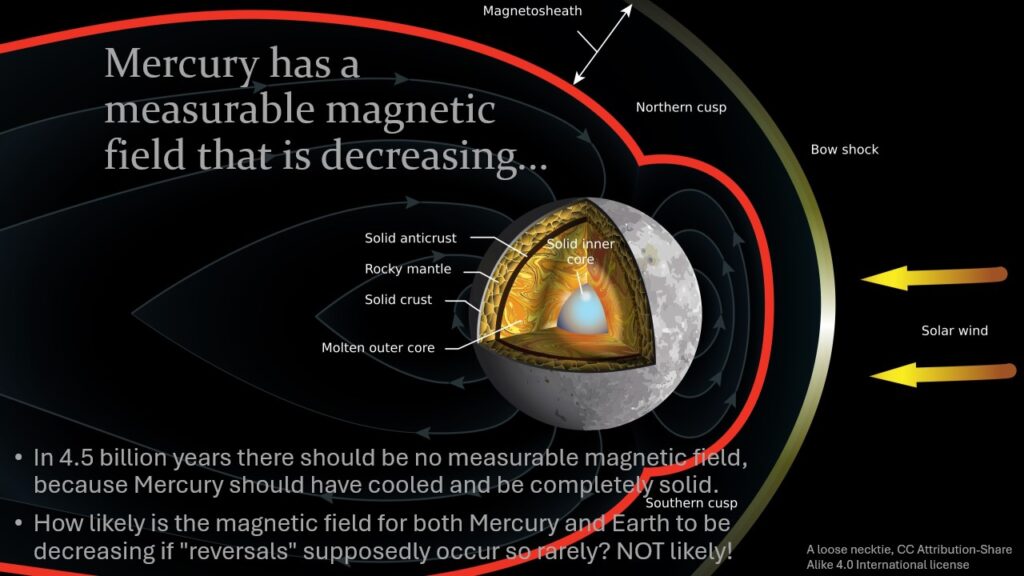
Examination of the moon rocks brought back by Apollo astronauts showed that they had formed in a magnetic field that was about twice as strong as Earth’s current field. The long-age “dynamo” model cannot explain this data. (8) Refer to the sections on Age of the Earth and Geology for more information regarding planetary magnetic fields.
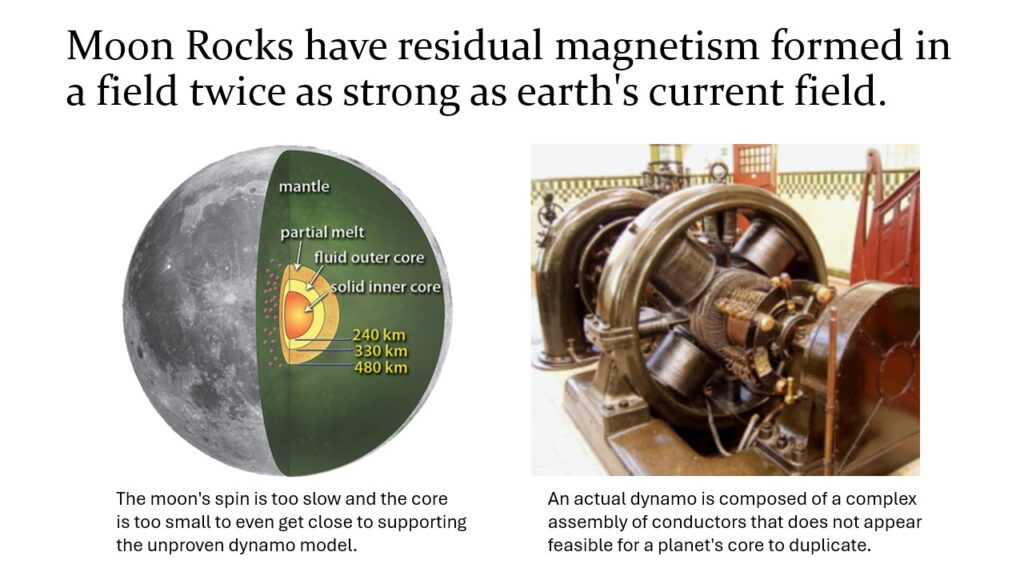
There are many other evidences, not discussed here, that indicate a young age for the universe and the solar system. Those can be researched on the various websites dedicated to investigating the evidence of a recent creation. The bottom line is that secular theories regarding the origin and age of the universe, solar system, and earth are just that—theories. Many secular assertions of age generally rely on just a handful of theoretical lines of inquiry, while the creation assertion of age utilizes multiple lines of scientific evidences and analyses because the majority of age dependent phenomena indicate maximum possible ages that are significantly less than the billions of years required by unguided and purposeless “evolutionary” theories. Those phenomena and conditions that are used to support long-ages of billions of years are based on unverified (and unverifiable) assumptions.
There are plenty of mysteries to go around...
While astronomy and cosmology pose far more mysteries than answers relative to other spheres of knowledge, those who seek answers to their life in the existence of a personal, loving God do not have to feel beholden or belittled by those who would claim there is no God. The actual mysteries are as impenetrable to them, as they currently are to all of us. The reader is encouraged to explore the many avenues supporting age analyses available on the creation websites. Refer to the Overview page for a list of creation-oriented websites.
References:
(1) Humphreys, D. R., Starlight and Time book and video
(2) Meyer, Stephen, Return of the God Hypothesis, p. 128-133
(3) Ibid., p. 305
(4) Ibid., p. 70
(5) The Age of the Universe, Part 1, AIG website
(6) Saturnian system is young!, CMI website
(7) The Age of the Universe, Part 2, AIG website
(8) Humphreys, D.R. et al, 2015, Earth’s Mysterious Magnetism, Sec 2.I. The Planets’ Mysterious Magnetism